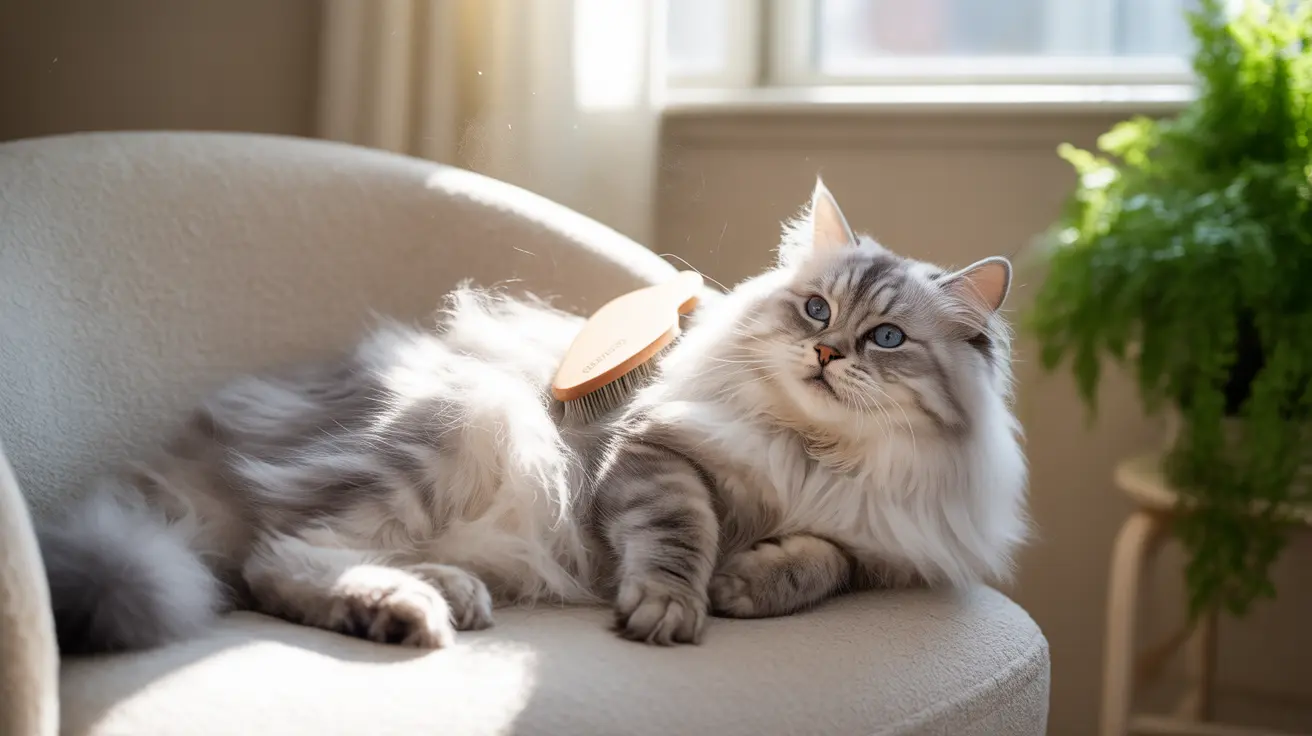The Complete Spring Health Checkup for Cats: Essential Seasonal Care Guide
As winter melts away and spring arrives, it's the perfect time to give your feline companion a comprehensive health checkup. A spring health checkup for cats is more than just a routine vet visit—it's an opportunity to reset your cat's health routine after the indoor months of winter and prepare them for the more active seasons ahead. This seasonal transition brings unique challenges and opportunities for your cat's wellbeing, from managing increased shedding to preventing parasites that become more active in warmer weather.
During spring, cats naturally undergo physiological changes as they shed their winter coats and potentially become more active. This makes it an ideal time to assess their overall health, update preventive care measures, and establish routines that will keep them healthy throughout the year. Whether you have an indoor cat who's been less active during winter or an outdoor adventurer ready to explore, a thorough spring health evaluation ensures your feline friend is ready for the seasons ahead.
This comprehensive guide will walk you through everything you need to know about conducting a proper spring health checkup for cats, including grooming strategies, parasite prevention, nutritional adjustments, and the importance of professional veterinary care—especially for senior cats who require more frequent monitoring.
Why Spring is the Ideal Time for Cat Health Checkups
Spring represents a natural reset for your cat's health routine. After months of indoor living during winter, many cats experience changes in their activity levels, coat condition, and overall metabolism. This seasonal transition makes it the perfect time to evaluate your cat's current health status and make necessary adjustments to their care routine.
During spring, cats naturally begin their shedding cycle, losing their thick winter coats in preparation for warmer weather. This process can lead to increased hairball formation if not properly managed through regular grooming. Additionally, as temperatures warm and your cat potentially spends more time outdoors or near open windows, exposure to parasites like fleas and ticks increases significantly.
The timing also aligns well with annual veterinary care schedules. Adult cats should have annual exams, while middle-aged, senior, and geriatric cats are recommended to have exams twice yearly. Spring checkups ensure that vaccinations are current before the active outdoor season begins and allow for early detection of any health issues that may have developed during the less active winter months.
Essential Grooming and Shedding Management
Spring shedding is one of the most noticeable changes in your cat's seasonal routine. As cats lose their winter coats, regular brushing becomes crucial for preventing hairballs and maintaining coat health. However, many cats are not naturally comfortable with grooming routines, making gradual medical training an essential component of spring health preparation.
Medical training involves slowly acclimating your cat to handling and grooming procedures through positive reinforcement. Start by gently touching areas that will need grooming—such as the back, sides, and eventually more sensitive areas like the belly and legs—while offering treats and praise. This gradual approach helps cats become more comfortable with grooming sessions and reduces stress during both home care and veterinary visits.
Effective Brushing Techniques
Begin brushing sessions when your cat is relaxed, such as after a meal or during their usual petting time. Use appropriate brushes for your cat's coat type—slicker brushes work well for most cats, while long-haired breeds may need specialized tools. Start with short, gentle sessions of just a few minutes, gradually increasing duration as your cat becomes more comfortable.
Focus on areas where mats commonly form, including behind the ears, under the legs, and on the belly. Pay special attention to areas where your cat cannot easily groom themselves. Regular brushing during spring shedding season should occur daily or every other day, depending on your cat's coat length and shedding intensity.
Comprehensive Parasite Prevention and Control
Spring's warmer temperatures activate various parasites that pose significant health risks to cats. Effective parasite prevention should begin early in the season, especially for cats with outdoor access. The most common spring parasites include fleas, ticks, and various internal parasites that can affect both your cat's health and potentially pose zoonotic risks to human family members.
Flea prevention is particularly critical as these parasites can quickly infest both your cat and your home environment. Modern flea preventatives are highly effective when applied consistently, and many provide month-long protection. Tick prevention is equally important, as ticks can transmit diseases and become more active as temperatures rise.
Internal Parasite Management
Regular deworming schedules become especially important during spring health checkups. Internal parasites can compromise your cat's immune system and overall health while potentially creating zoonotic risks for humans. Your veterinarian will often recommend collecting a fresh fecal sample before the exam to test for internal parasites, which is especially important in kittens but beneficial for cats of all ages.
Common internal parasites include roundworms, tapeworms, and hookworms, each requiring specific treatment approaches. Some cats may benefit from probiotic treatments to support digestive health during or after deworming treatments, helping maintain healthy gut bacteria balance and supporting immune function.
Recognizing Subtle Signs of Illness
Cats are masters at hiding signs of illness, making regular observation and professional examinations crucial for early detection. During your spring health assessment, watch for subtle changes that owners often miss but that can indicate developing health issues.
Changes in appearance, energy levels, coat quality, appetite, litter box habits, breathing patterns, and weight can all signal health concerns. Early signs might include slightly decreased appetite, minor changes in grooming habits, subtle changes in litter box usage, or small variations in activity levels. These seemingly minor changes can indicate significant health issues when detected early by trained veterinary professionals.
Physical Examination Components
A thorough physical examination assesses your cat's general alertness, gait, skin and coat condition, body condition, weight, temperature, heart rate, respiratory rate, and capillary refill time. Veterinarians also examine the eyes, ears, nose, mouth, lymph nodes, heart and lungs, abdomen, and thyroid glands during comprehensive wellness exams.
Some examination components may not be obvious to owners if no abnormalities are found, but professional assessment can detect subtle changes that indicate developing health issues before they become serious problems.
Spring Nutrition and Weight Management
Post-winter body condition assessment is crucial for maintaining your cat's optimal health. Many cats gain weight during winter months due to decreased activity and increased caloric intake. Spring provides an excellent opportunity to evaluate your cat's body condition and make necessary dietary adjustments.
Proper weight management involves assessing your cat's body condition score and adjusting food portions accordingly. Cats should have a visible waist when viewed from above and ribs that can be felt but not seen. If your cat has gained weight during winter, gradual portion reduction combined with increased activity is the safest approach to weight management.
Nutritional Adjustments for Spring
Spring dietary considerations may include adjusting portion sizes based on increased activity levels and ensuring adequate nutrition to support coat health during shedding season. Some cats benefit from foods with added omega fatty acids to support skin and coat health, while others may need digestive support during the transition to more active lifestyles.
Discuss any dietary changes with your veterinarian during the spring checkup, especially if your cat has specific health conditions or is taking medications that might interact with dietary modifications.
Interactive Play and Mental Stimulation
Increasing exercise through interactive play is essential for maintaining healthy weight and fitness as cats transition from winter's lower activity levels. Interactive play provides both physical exercise and mental stimulation, supporting overall wellness and helping prevent obesity-related health issues.
Effective interactive play involves toys that trigger your cat's hunting instincts, such as feather wands, laser pointers (always ending with a physical toy they can catch), and puzzle feeders. Schedule regular play sessions, ideally before meals when cats are naturally more motivated to hunt.
Indoor vs. Outdoor Activity Considerations
Indoor cats may need more structured play activities to compensate for limited environmental stimulation, while outdoor cats benefit from supervised outdoor time as weather improves. Both indoor and outdoor cats benefit from environmental enrichment, including climbing structures, scratching posts, and rotating toys to maintain interest.
Mental stimulation through puzzle feeders, treat-dispensing toys, and environmental changes helps prevent boredom and supports psychological wellness during the spring transition period.
Professional Veterinary Care and Senior Cat Considerations
Regular veterinary checkups become increasingly important as cats age. Cats older than seven years benefit from annual blood tests and more frequent examinations to monitor for age-related health changes. Senior cats (11-14 years) and geriatric cats (over 15 years) should have examinations twice yearly due to their higher risk for developing various health conditions.
Wellness screening tests typically include a complete blood count (CBC), biochemistry profile, urinalysis, and thyroid hormone testing. The extent of testing depends on your cat's age and health status. Older cats may require additional diagnostics such as chest or abdominal radiographs and blood pressure measurements to detect conditions common in senior pets.
What to Expect During Professional Examinations
During a wellness examination, your veterinarian will ask about your cat's diet, exercise, drinking habits, breathing, behavior, litter box habits, and lifestyle factors. They will perform a comprehensive physical examination checking for vaccination needs, parasite control requirements, nutrition status, skin and coat condition, joint health, weight management needs, and dental care requirements.
The veterinarian may also recommend other life-stage or lifestyle-specific treatments based on your cat's individual needs and risk factors. This personalized approach ensures that your cat receives care tailored to their specific circumstances and health status.
Vaccination Updates and Preventive Care
Spring is an excellent time to review and update your cat's vaccination schedule. Routine vaccines protect against feline calicivirus, herpes virus, infectious enteritis, and feline leukemia virus (particularly important for kittens or immune-compromised cats). Vaccination schedules depend on your cat's age, health status, and lifestyle factors.
Adult cats typically receive annual boosters, though some vaccines may be given every three years depending on the specific vaccine and your cat's risk factors. Your veterinarian will recommend an appropriate vaccination schedule based on current guidelines and your cat's individual circumstances.
Additional Preventive Measures
Beyond vaccinations, spring preventive care includes updating parasite prevention plans, reviewing dental health needs, and assessing any necessary diagnostic testing. Heartworm testing might be recommended in certain geographic areas where this parasite is prevalent.
Dental health evaluation is particularly important, as dental disease can significantly impact your cat's overall health and quality of life. Early detection of dental issues allows for less invasive treatment and better outcomes.
Frequently Asked Questions
- How often should I schedule wellness exams for my cat during spring and throughout the year?
Adult cats should have annual exams, while senior cats (over 7 years) benefit from twice-yearly checkups. Kittens require monthly exams during early kittenhood. Spring is ideal for annual exams as it prepares cats for the more active seasons ahead and allows for parasite prevention planning.
- What specific spring grooming routine should I establish for my shedding cat?
During spring shedding season, brush your cat daily or every other day using appropriate tools for their coat type. Use gradual medical training to help your cat become comfortable with grooming sessions, starting with short, gentle sessions and gradually increasing duration as tolerance improves.
- When should I start spring parasite prevention, and what parasites should I be most concerned about?
Begin parasite prevention early in spring before temperatures consistently warm up. Focus on flea and tick prevention for all cats, especially those with outdoor access. Internal parasite screening through fecal testing helps identify and treat roundworms, tapeworms, and other intestinal parasites.
- What signs indicate my cat might need immediate veterinary attention during the spring transition?
Watch for changes in appetite, litter box habits, energy levels, breathing patterns, coat quality, and weight. Subtle changes like decreased grooming, minor appetite changes, or slight alterations in activity levels can indicate developing health issues that benefit from early professional evaluation.
- How should I adjust my cat's diet and exercise routine for spring?
Assess your cat's body condition after winter and adjust food portions if weight gain occurred. Increase interactive play sessions to support weight management and fitness. Consider foods with omega fatty acids to support coat health during shedding season, and always discuss dietary changes with your veterinarian.
- What additional health screenings do senior cats need during spring checkups?
Senior cats should receive blood work including complete blood count, biochemistry profiles, urinalysis, and thyroid testing. Additional diagnostics may include chest radiographs, blood pressure measurement, and more frequent examinations (every six months) to monitor for age-related health changes.
- How can I prepare my cat for spring veterinary visits to reduce stress?
Use gradual medical training to help your cat become comfortable with handling and carrier transport. Choose cat-only clinics when possible to reduce stress, bring familiar blankets or treats, and practice short carrier trips before the actual appointment to build positive associations.
Conclusion
A comprehensive spring health checkup for cats encompasses much more than a simple veterinary visit—it's a holistic approach to ensuring your feline companion's optimal health throughout the year. By addressing grooming needs during seasonal shedding, implementing effective parasite prevention strategies, managing nutrition and exercise, and maintaining regular professional veterinary care, you create a foundation for your cat's long-term wellness.
The seasonal transition of spring provides a natural opportunity to reset health routines, assess your cat's condition after winter, and prepare for the more active months ahead. Whether you're caring for a young adult cat or a senior feline requiring more frequent monitoring, establishing consistent spring health practices helps detect potential issues early and maintains your cat's quality of life. Remember that cats are masters at hiding illness, making professional examinations and your careful observation equally important components of comprehensive health care.






